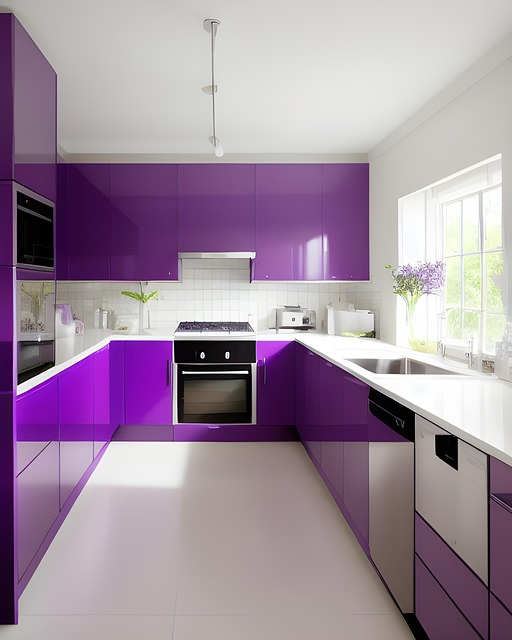Designing effective spaces for responsible waste sorting and recycling involves integrating intuitive, visible, and accessible systems, like clear bin labeling and strategically placed bins, along with energy-efficient kitchen appliances. These modern appliances, such as compost bins and automated sorters, streamline the process, making recycling a convenient part of daily routines while reducing environmental impact and fostering eco-friendly habits in contemporary kitchens. Clear signage, well-designed labels, and strategic bin placement enhance inclusivity and proper sorting habits, contributing to a cleaner, greener home environment and continuous improvement through feedback and adaptation to new technologies.
Designing spaces that encourage responsible waste sorting is key to a sustainable future. This article explores how to integrate recycling bins seamlessly into your kitchen design, leveraging insights into human behavior and practical considerations. From understanding the importance of waste sorting to optimizing user experience with accessible stations, we delve into strategies that make eco-conscious living easier. Additionally, discover how energy-efficient kitchen appliances complement recycling efforts, promoting a greener lifestyle without compromising convenience.
Understanding Waste Sorting and Recycling Behavior
Understanding waste sorting and recycling behavior is crucial for designing effective spaces that encourage responsible practices. Research shows that individuals are more likely to engage in proper waste segregation when systems are intuitive, visible, and accessible. This means clearly labeling bins for different materials (paper, plastic, glass, organic waste) and strategically placing them within easy reach can significantly enhance sorting accuracy. Additionally, integrating energy-efficient kitchen appliances that facilitate recycling, such as compost bins for food scraps and automated sorting technologies, can further streamline the process. By making recycling a convenient and natural part of daily routines, we can foster a culture of sustainable waste management.
Integrating Recycling Bins into Kitchen Design
When designing a kitchen, integrating recycling bins can be an elegant and practical solution for encouraging proper waste sorting. Strategically placing bins near sinks or in convenient corners allows for easy access during food preparation. Modern designs offer sleek, hidden compartments that blend seamlessly with contemporary kitchens, featuring energy-efficient appliances. This approach ensures that recycling becomes second nature, as household members can quickly dispose of recyclable materials while washing dishes or preparing meals.
Incorporating recycling bins into the kitchen layout not only promotes eco-friendly habits but also complements the growing trend towards sustainable living. By making waste sorting effortless and aesthetically pleasing, homeowners are more likely to adhere to proper recycling practices, contributing to a cleaner, greener environment.
Energy-Efficient Appliances: A Complement to Recycling
In today’s eco-conscious world, designing a space that promotes proper waste sorting is not just an aesthetic choice but a step towards a greener future. One effective companion to this endeavor is the integration of energy-efficient kitchen appliances. These appliances are designed not only to reduce environmental impact through lower energy consumption but also to encourage responsible behavior among users. For instance, efficient refrigerators with smart sensors can monitor food stock and optimize cooling, minimizing energy waste.
Energy-efficient kitchen appliances play a dual role in fostering sustainable practices. They educate users about resource conservation, as their advanced features often include eco-mode settings and automatic shut-off functions. At the same time, they incentivize correct waste management by reducing utility bills, making recycling more appealing and beneficial for both the environment and the user’s wallet.
User Experience and Accessibility in Recycling Stations
Creating an intuitive and accessible recycling station is key to promoting proper waste sorting. Users should be able to easily identify different bins for paper, plastic, glass, and metal, with clear signage that avoids jargon or complex diagrams. Well-designed labels, braille options, and audible cues for visually impaired users enhance the overall experience, making it inclusive for everyone.
Integrating recycling stations into existing spaces, especially in homes with energy-efficient kitchen appliances, requires thoughtful planning. Strategically placing bins near garbage disposals or compactors streamlines the waste management process. Additionally, ensuring enough space around each bin allows for convenient access and encourages users to adopt a sorting habit, contributing to a cleaner, more sustainable environment.
Measuring Success and Continuous Improvement
Measuring success and adopting a continuous improvement mindset are vital aspects of creating an effective recycling system. Success can be evaluated by assessing the adoption rate of proper waste sorting among residents, which can be measured through surveys or feedback mechanisms. Additionally, tracking the volume and types of recyclables collected provides valuable insights into the program’s effectiveness. For instance, observing a significant increase in recycled materials over time indicates that the space design and educational efforts are paying off.
Continuous improvement involves regularly reviewing and refining the recycling process. This could include analyzing common challenges residents face and tailoring solutions accordingly. As people become more accustomed to energy-efficient kitchen appliances and sustainable practices, the recycling program can evolve to accommodate new types of materials and technologies, ensuring that the space remains optimized for waste sorting and environmental conservation.
Designing an efficient space for recycling bins is a key step towards fostering responsible waste sorting behavior. By integrating these stations seamlessly into kitchen areas, we can encourage everyday eco-conscious practices. Combining this with the use of energy-efficient kitchen appliances creates a sustainable environment that not only reduces waste but also minimizes energy consumption. Continuous improvement, based on user experience and accessibility, ensures that recycling becomes an intuitive part of our daily routines, contributing to a greener future.
